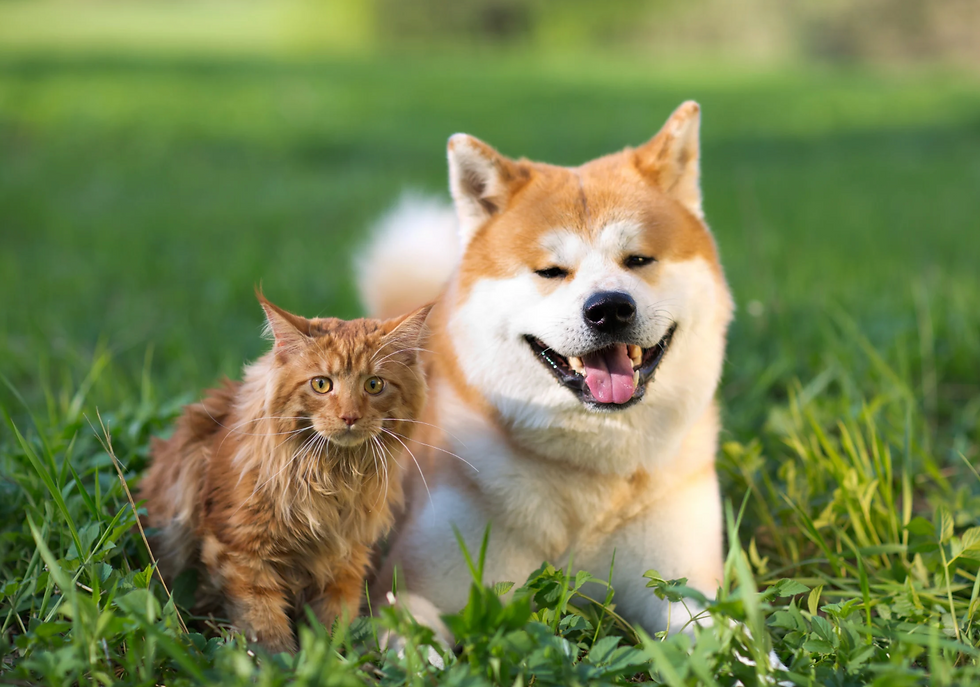Beware of These Garden Plants: Protect Your Pets from Hidden Dangers
- Tyana Fenton
- Jul 22, 2024
- 3 min read
Updated: Aug 20, 2024
Gardening can be a relaxing and rewarding hobby, but it’s important to be aware of the potential dangers that some plants pose to our pets. Many common garden plants can be toxic to dogs and cats, leading to a variety of health issues if ingested. In this blog, we’ll highlight some of the most hazardous plants, the symptoms of poisoning to watch out for, and how to keep your furry friends safe.
Common Toxic Garden Plants
1.Lilies
Danger: Extremely toxic to cats; can cause kidney failure.
Symptoms: Vomiting, lethargy, loss of appetite, and increased urination.
Note: Even small amounts can be deadly.
2. Tulips and Daffodils
Danger: Bulbs contain toxins that are harmful to both dogs and cats.
Symptoms: Drooling, vomiting, diarrhea, and central nervous system depression.
Note: Most dangerous part is the bulb, which is often dug up by curious pets.
3. Azaleas and Rhododendrons
Danger: Contain grayanotoxins, which can affect the heart and muscles.
Symptoms: Vomiting, drooling, diarrhea, weakness, and heart arrhythmias.
Note: Even small amounts can cause serious health issues.
4. Oleander
Danger: Extremely toxic to pets and humans; contains cardiac glycosides.
Symptoms: Vomiting, decreased heart rate, and potentially deadly cardiac arrest.
Note: All parts of the plant are toxic.
5. Sago Palm
Danger: Seeds contain cycasin, which is highly toxic.
Symptoms: Vomiting, diarrhea, seizures, liver failure, and death.
Note: Requires immediate veterinary attention if ingested.
6. Foxglove
Danger: Contains digitalis glycosides, which affect heart function.
Symptoms: Nausea, vomiting, diarrhea, drooling, abnormal heart rate, and death.
Note: All parts of the plant are toxic.
7. Tomato Plants
Danger: Leaves and stems contain solanine, which is toxic to pets.
Symptoms: Hyper-salivation, severe gastrointestinal upset, depression, weakness, and dilated pupils (cats).
Note: The ripe fruit is generally safe; it's the green parts that pose a risk.
Symptoms of Plant Poisoning
If you suspect your pet has ingested a toxic plant, watch for these common symptoms:

Vomiting and diarrhea
Drooling or foaming at the mouth
Difficulty breathing
Lethargy or weakness
Changes in appetite
Seizures or tremors
Abnormal heart rate
Excessive thirst or urination
What to Do if Your Pet is Poisoned
Identify the Plant: If possible, identify the plant your pet has ingested.
Call Your Veterinarian: Contact your veterinarian immediately for advice.
Provide Information: Be prepared to provide information about the plant and the symptoms your pet is experiencing.
Follow Instructions: Follow your veterinarian’s instructions carefully. They may advise you to bring your pet in for emergency care.
Preventive Measures
Know Your Plants: Familiarize yourself with the plants in your garden and their potential risks.
Pet-Safe Gardening: Choose non-toxic plants for your garden. The ASPCA has a comprehensive list of safe and toxic plants.
Supervision: Supervise your pets while they are in the garden to prevent them from ingesting harmful plants.
Secure Your Garden: Use fencing or barriers to keep pets away from toxic plants.
Educate Family and Friends: Ensure everyone in your household is aware of the dangers and knows how to keep pets safe.
Product Spotlight: Pure Clean Pets
To help ensure your pet’s safety and well-being, consider using our product Pure Clean Pets. This innovative solution is designed to support your pet's health, especially if they've been exposed to potentially harmful substances in the garden.

Unlock Nature’s Most Powerful Crystal: Pure Clean Pets utilizes bioavailable silica and trace minerals that aid in the regeneration of your pet’s body.
Assists with the Removal of Pesticides: If your pet has ingested or been exposed to harmful pesticides, Pure Clean Pets can assist in removing these toxins from their system.
By incorporating Pure Clean Pets into your pet care routine, you can help protect your furry friends from the dangers of toxic plants and environmental pollutants. Always prioritize your pet’s health and well-being, and don’t hesitate to seek veterinary advice if you suspect they have ingested something harmful.
Authored By: Tyana Fenton




Comments